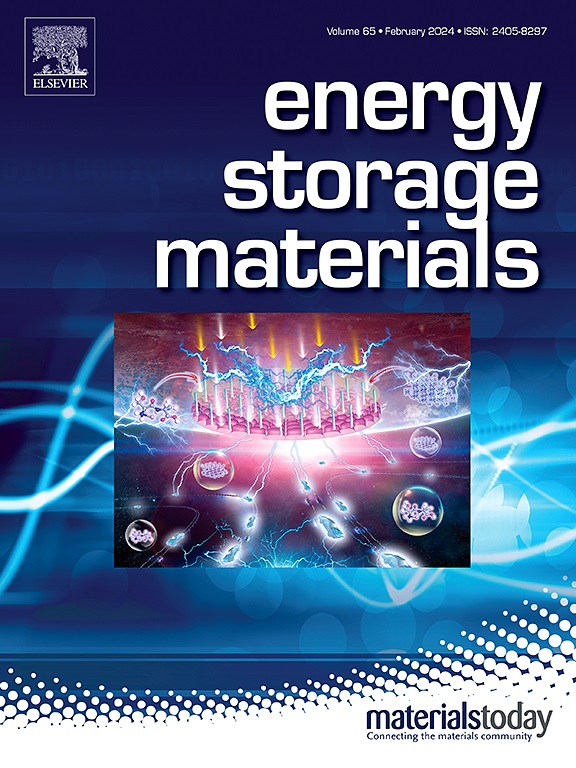Enabling efficient guiding of Li diffusion/plating toward high-performance lithium metal batteries by utilizing a gradient Janus interlayer
IF 18.9
1区 材料科学
Q1 CHEMISTRY, PHYSICAL
引用次数: 0
Abstract
Lithium metal batteries (LMBs) face significant challenges, including dendrite growth and degradation during cycling. Two effective strategies to address these issues involve utilizing a nano-structured current collector as a lithium host and forming an ideal solid-electrolyte interphase (SEI) as an artificial anode modifier. However, synthesizing an anode modifier that offers high cycling stability and efficient lithium diffusion/storage via a well-controlled deposition method remains challenging. This study presents a binder-free and novel gradient Janus interlayer(GJL) as anode modifier comprising gradient layered composite of fluorinated graphene (FECG) and intrinsic graphene (ECG), deposited through electrophoretic deposition (EPD). The gradient Janus structure provides separate ionic and electronic transport pathways. The top FECG layer with LiF-rich species enhances both electrolyte wettability and lithium ion transport for uniform Li plating, while the underlying ECG layer facilitates efficient electron transfer. Also, a thin CuF2-riched functional layer is designed to connecting the GJL to the copper substrate, ensures strong adhesion to the copper substrate without using any binder, enabling stable lithium deposition and improved structural integrity. The GJL as anode modifier demonstrates outstanding electrochemical performance, showing a low nucleation overpotential of 42.17 mV and stable polarization over 600 h. After 325 cycles, the Coulombic efficiency reached 97.2 %, indicating excellent stability. In full-cell testing, the specific capacity exceeded 120 mAh/g after 150 cycles, with 72 % capacity retention after 160 cycles. Overall, this innovative composite multilayer ASEI offers a promising solution to overcome the challenges of anode-free lithium metal batteries (AFLB), paving the way for safer and higher-energy-density battery technologies.


利用梯度Janus中间层,有效引导Li扩散/镀向高性能锂金属电池
锂金属电池(lmb)面临着重大挑战,包括循环过程中枝晶的生长和降解。解决这些问题的两种有效策略包括利用纳米结构的集流器作为锂载体,以及形成理想的固体-电解质界面(SEI)作为人工阳极改性剂。然而,通过控制良好的沉积方法合成具有高循环稳定性和高效锂扩散/存储的阳极改性剂仍然具有挑战性。本研究提出了一种无粘结剂的新型梯度Janus夹层(GJL)作为阳极改性剂,由电泳沉积(EPD)沉积的氟化石墨烯(FECG)和本征石墨烯(ECG)的梯度层状复合材料组成。梯度Janus结构提供了独立的离子和电子传递途径。富liff物质的上层FECG层提高了电解质的润湿性和锂离子的传输,从而实现均匀的镀锂,而下层ECG层促进了有效的电子传递。此外,设计了一层薄薄的富cuf2功能层,将GJL连接到铜衬底上,确保在不使用任何粘合剂的情况下与铜衬底具有强附着力,从而实现稳定的锂沉积并提高结构完整性。阳极改性剂GJL表现出优异的电化学性能,成核过电位低,为42.17 mV,极化时间超过600小时稳定。循环325次后,库仑效率达到97.2%,稳定性良好。在全电池测试中,150次循环后比容量超过120 mAh/g, 160次循环后容量保持率为72%。总的来说,这种创新的复合多层ASEI为克服无阳极锂金属电池(AFLB)的挑战提供了一个很有前途的解决方案,为更安全和更高能量密度的电池技术铺平了道路。
本文章由计算机程序翻译,如有差异,请以英文原文为准。
求助全文
约1分钟内获得全文
求助全文
来源期刊

Energy Storage Materials
Materials Science-General Materials Science
CiteScore
33.00
自引率
5.90%
发文量
652
审稿时长
27 days
期刊介绍:
Energy Storage Materials is a global interdisciplinary journal dedicated to sharing scientific and technological advancements in materials and devices for advanced energy storage and related energy conversion, such as in metal-O2 batteries. The journal features comprehensive research articles, including full papers and short communications, as well as authoritative feature articles and reviews by leading experts in the field.
Energy Storage Materials covers a wide range of topics, including the synthesis, fabrication, structure, properties, performance, and technological applications of energy storage materials. Additionally, the journal explores strategies, policies, and developments in the field of energy storage materials and devices for sustainable energy.
Published papers are selected based on their scientific and technological significance, their ability to provide valuable new knowledge, and their relevance to the international research community.
 求助内容:
求助内容: 应助结果提醒方式:
应助结果提醒方式:


